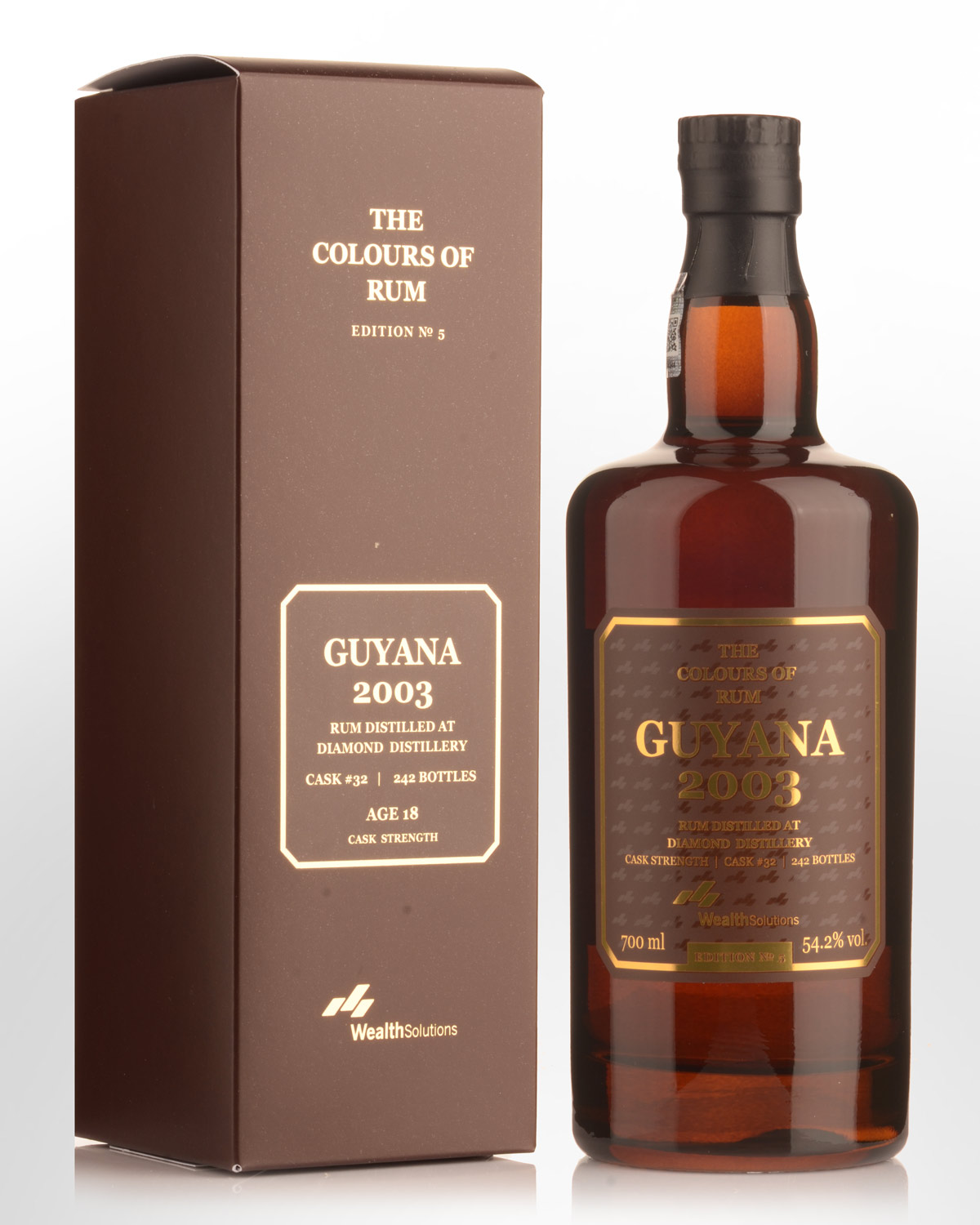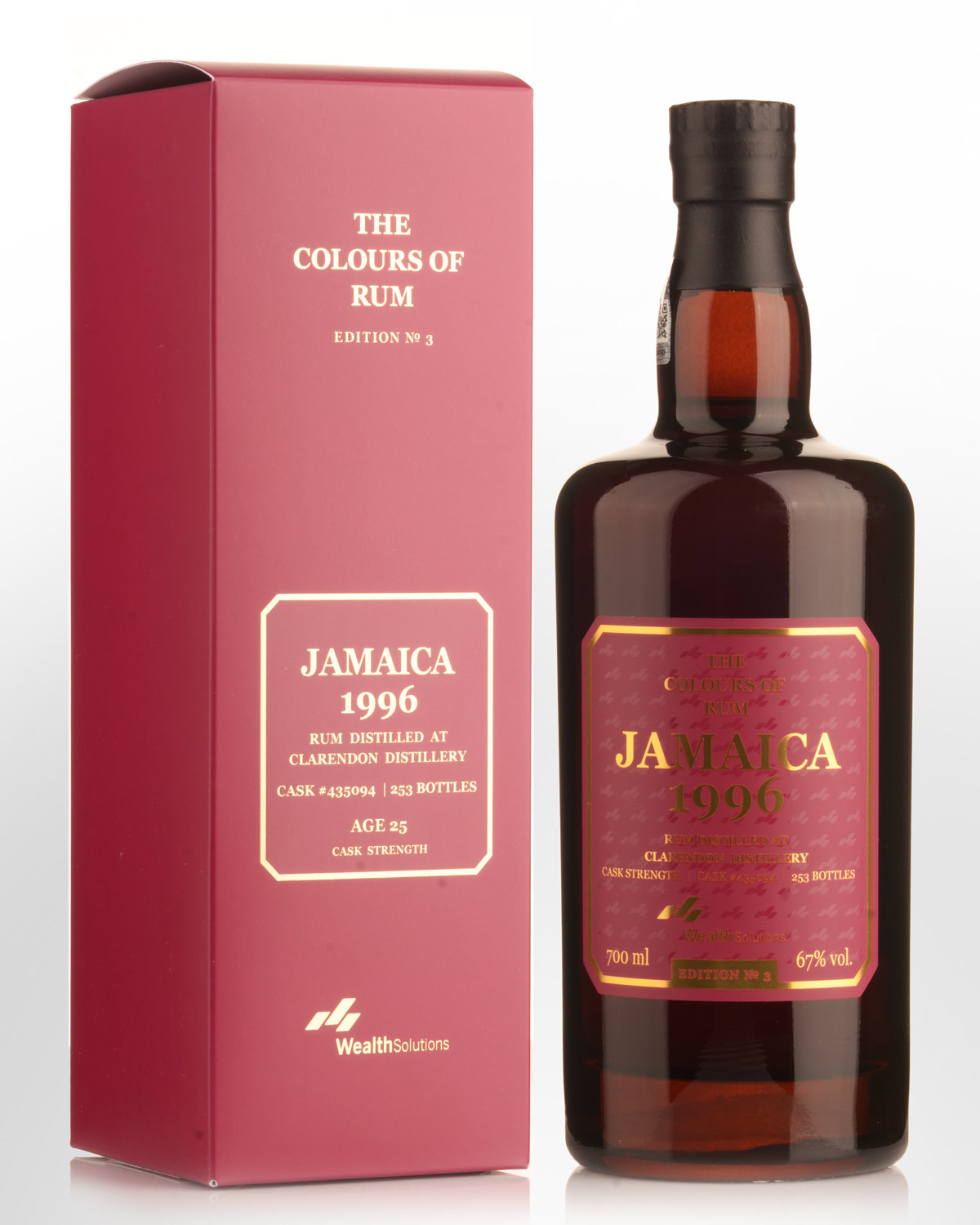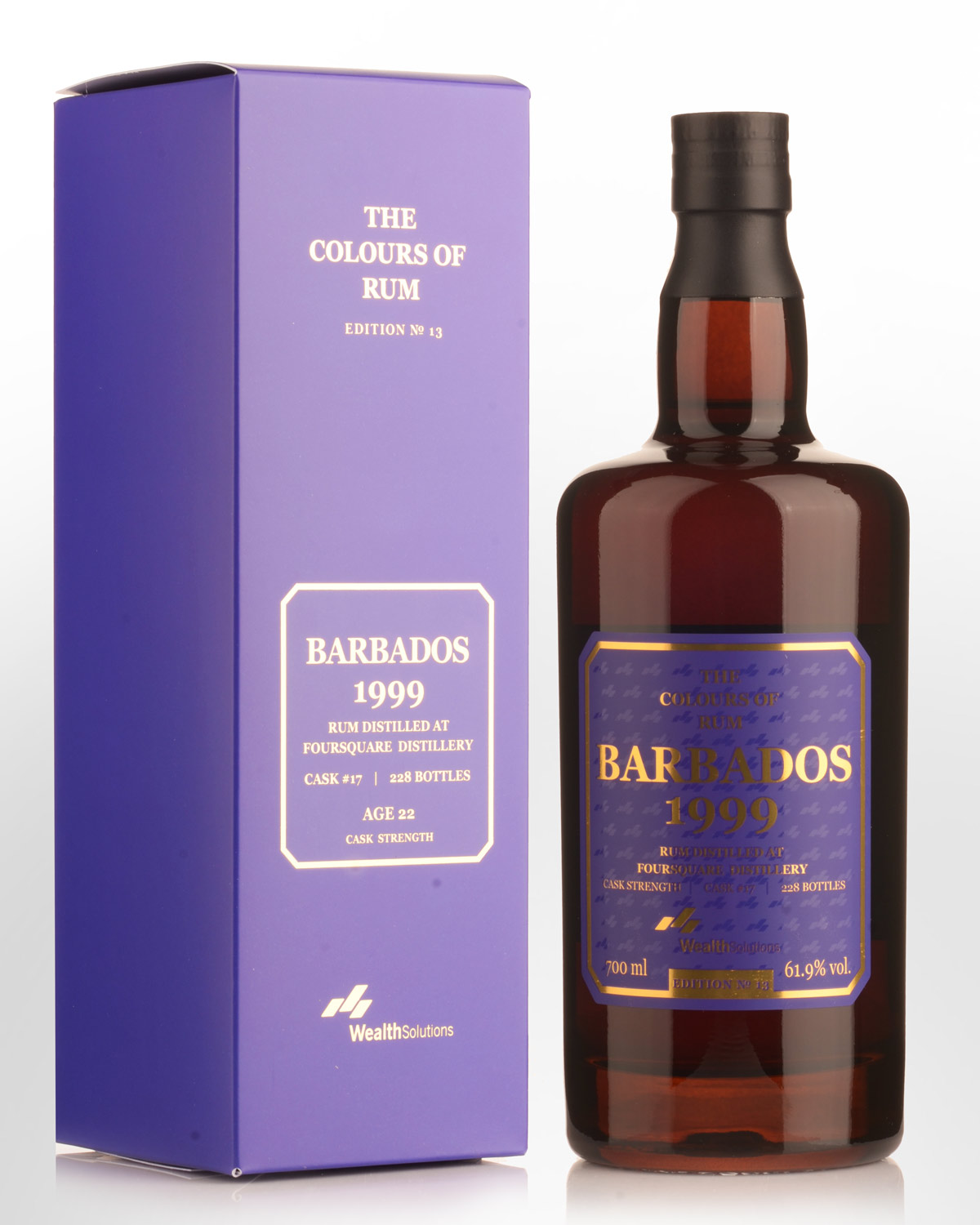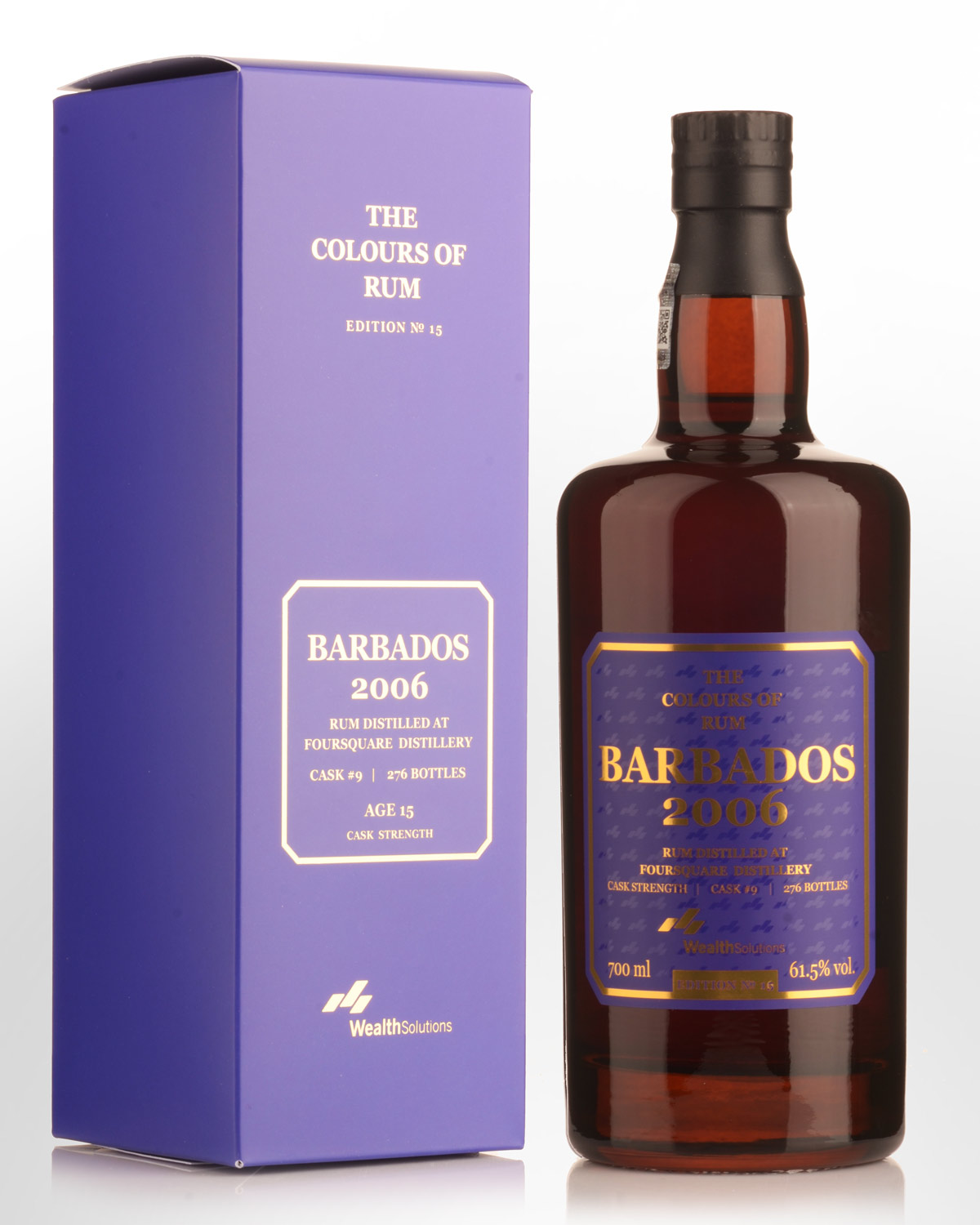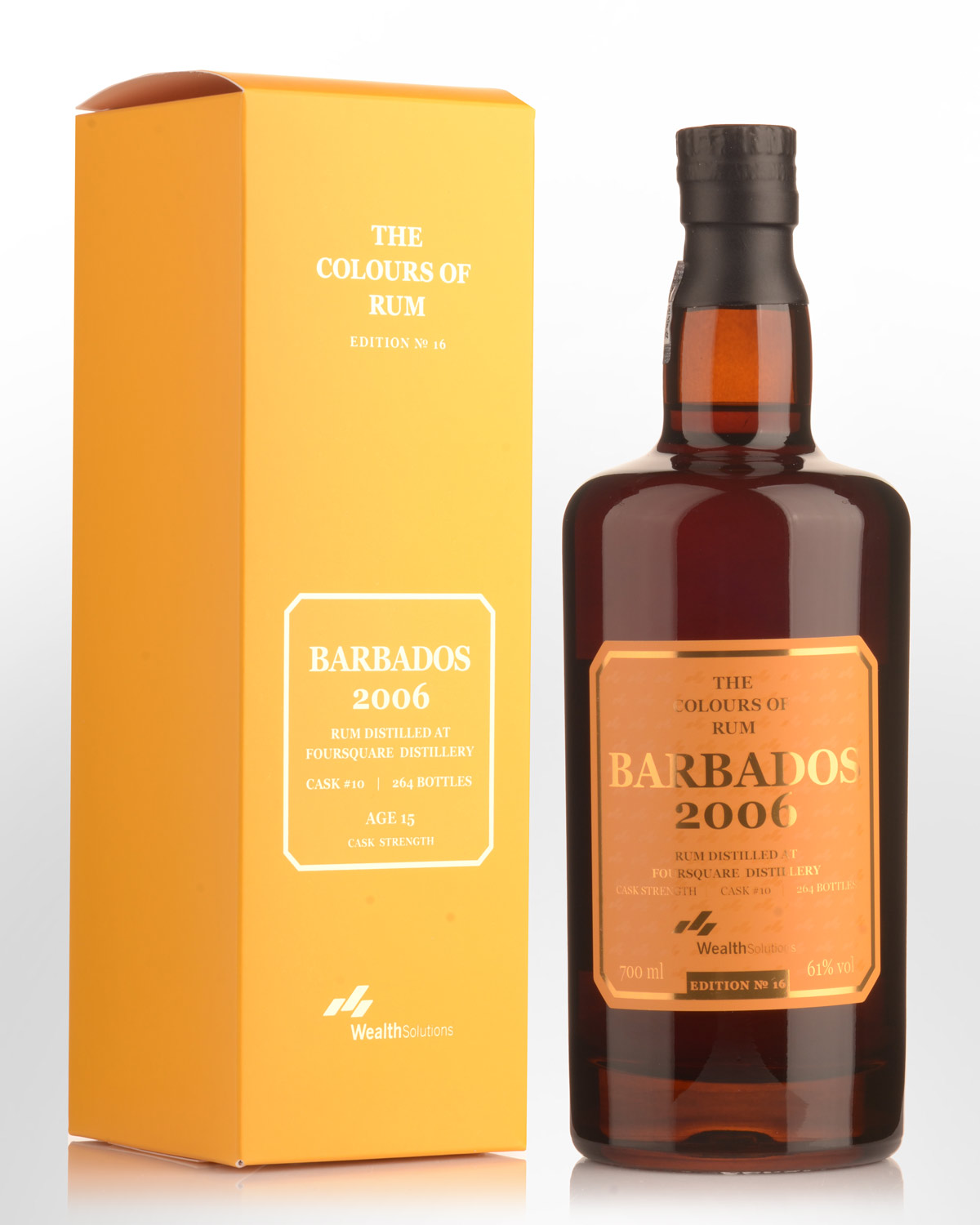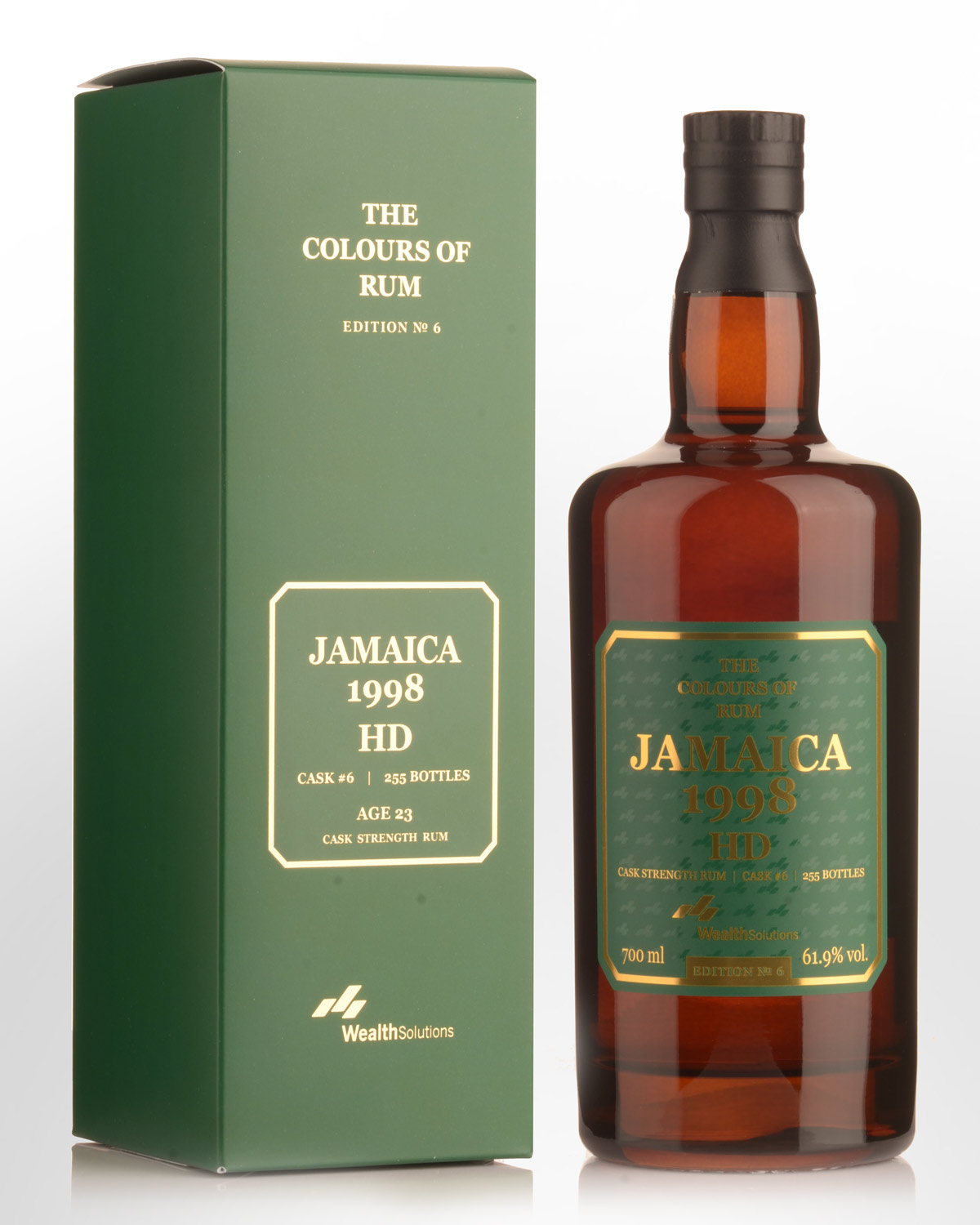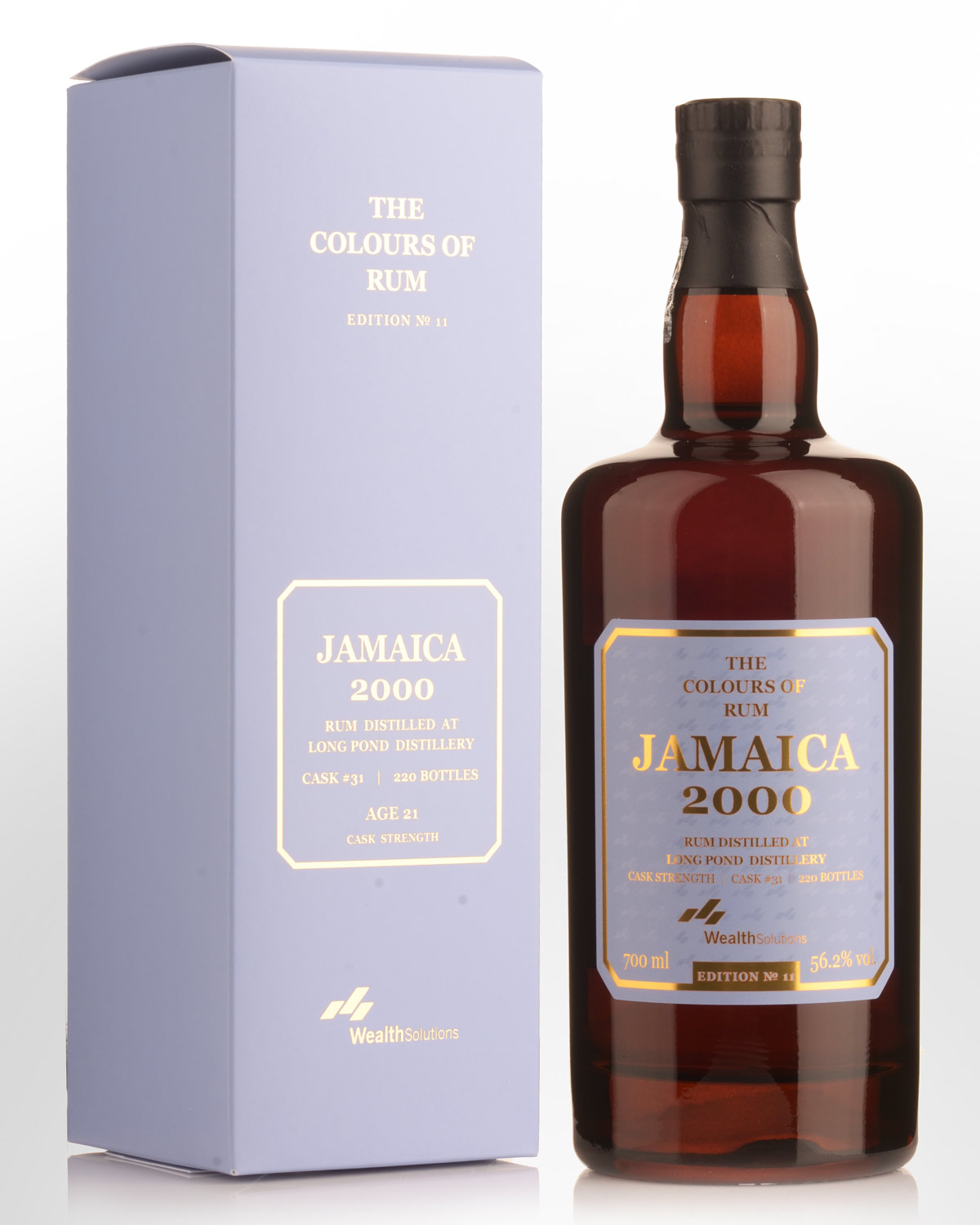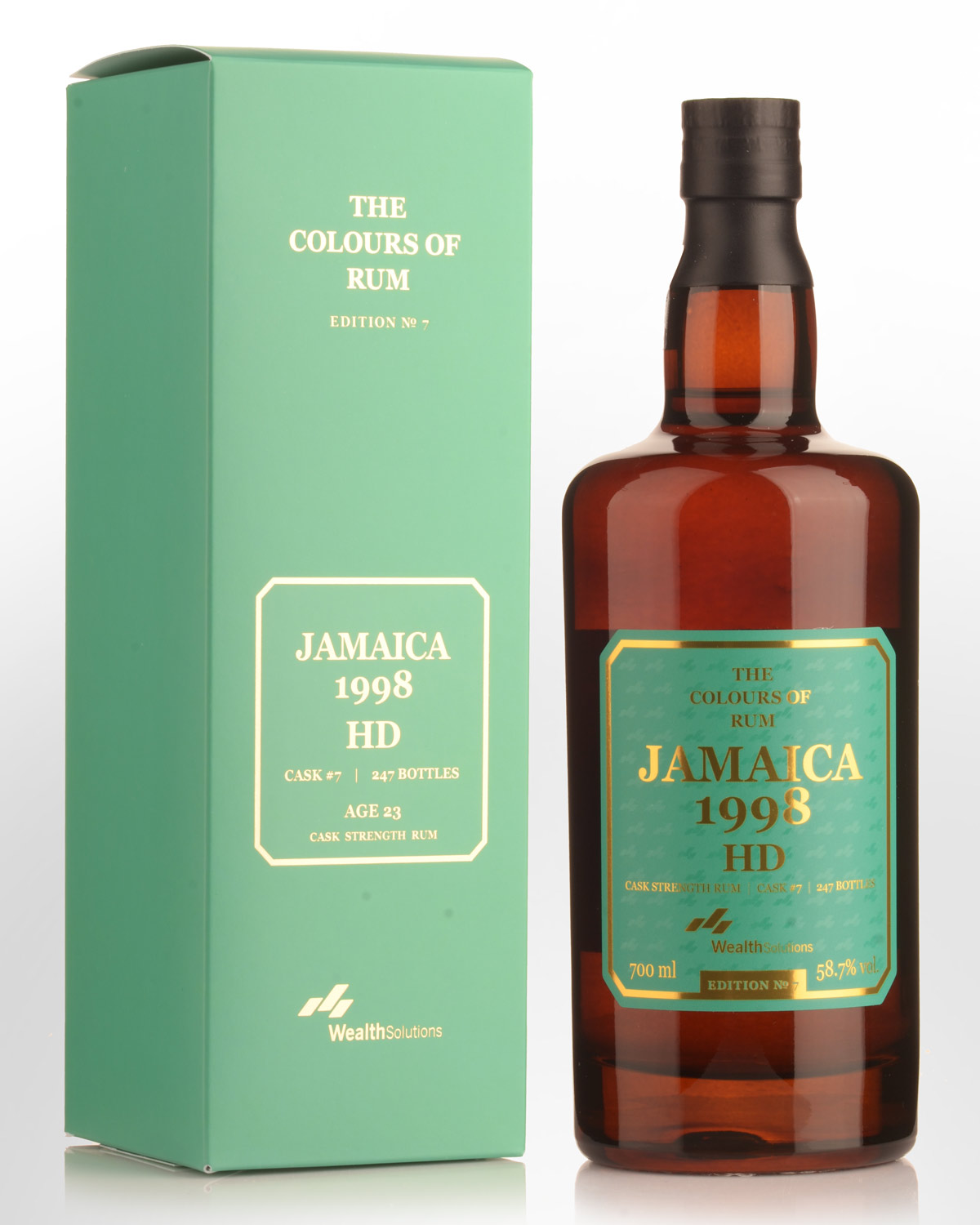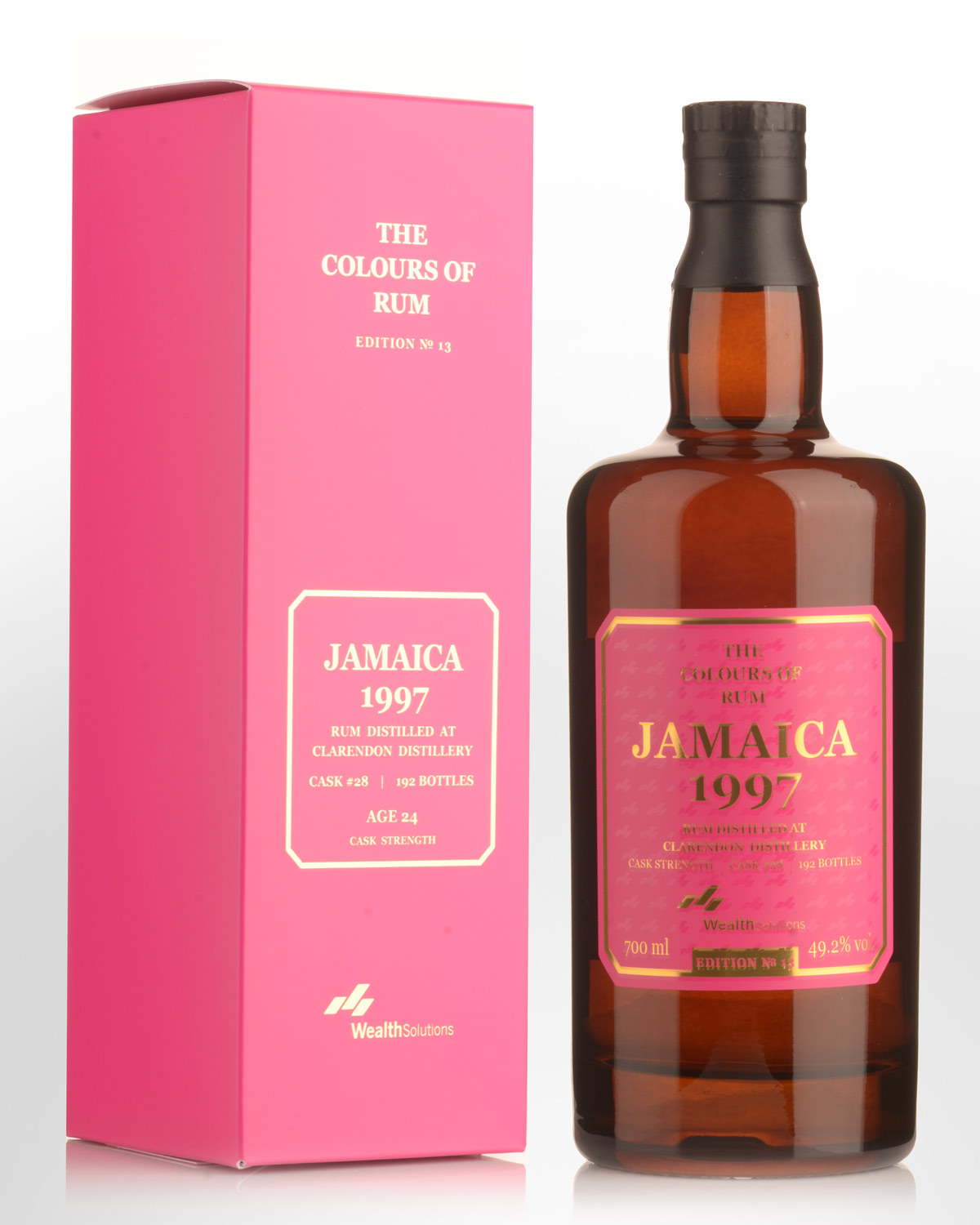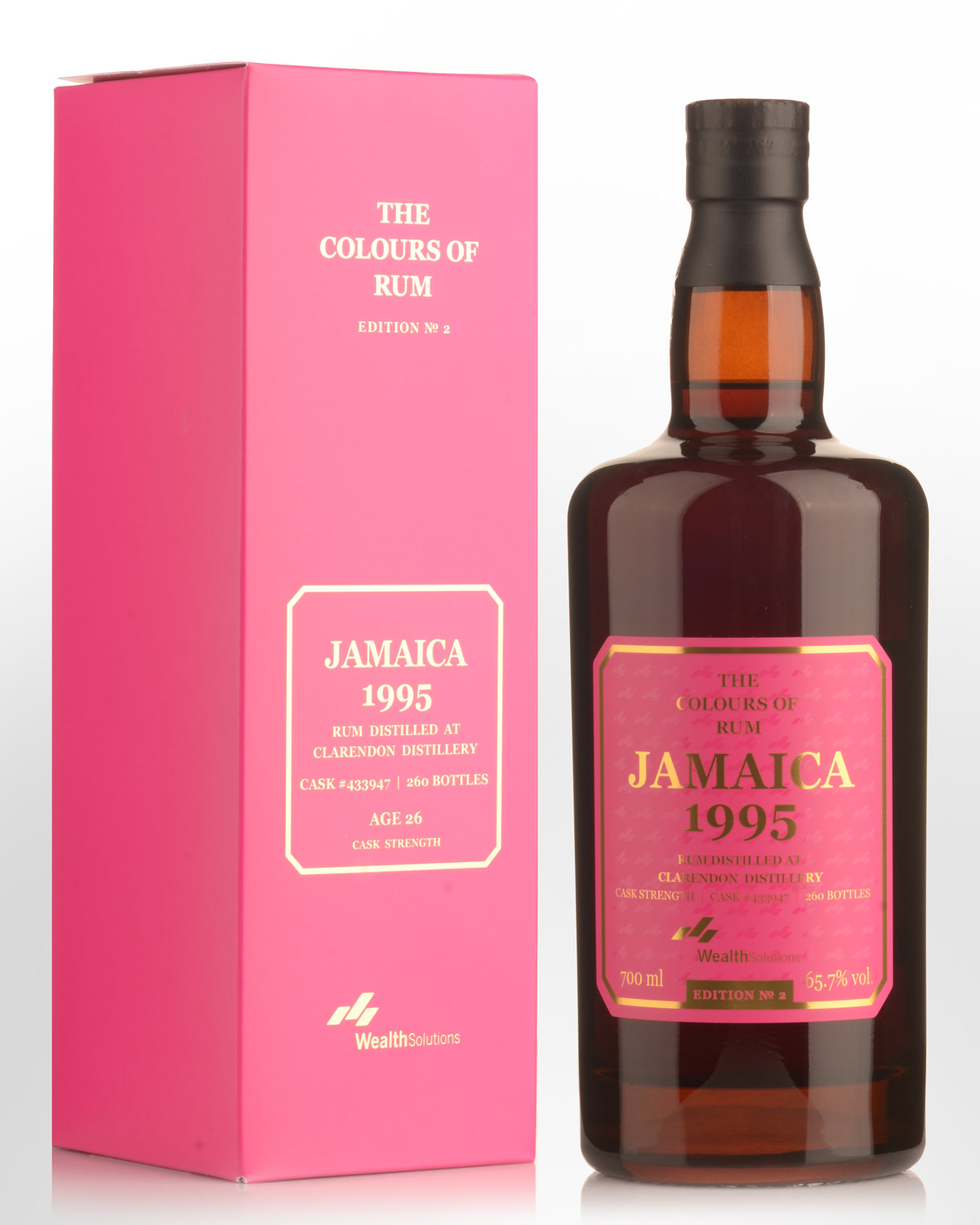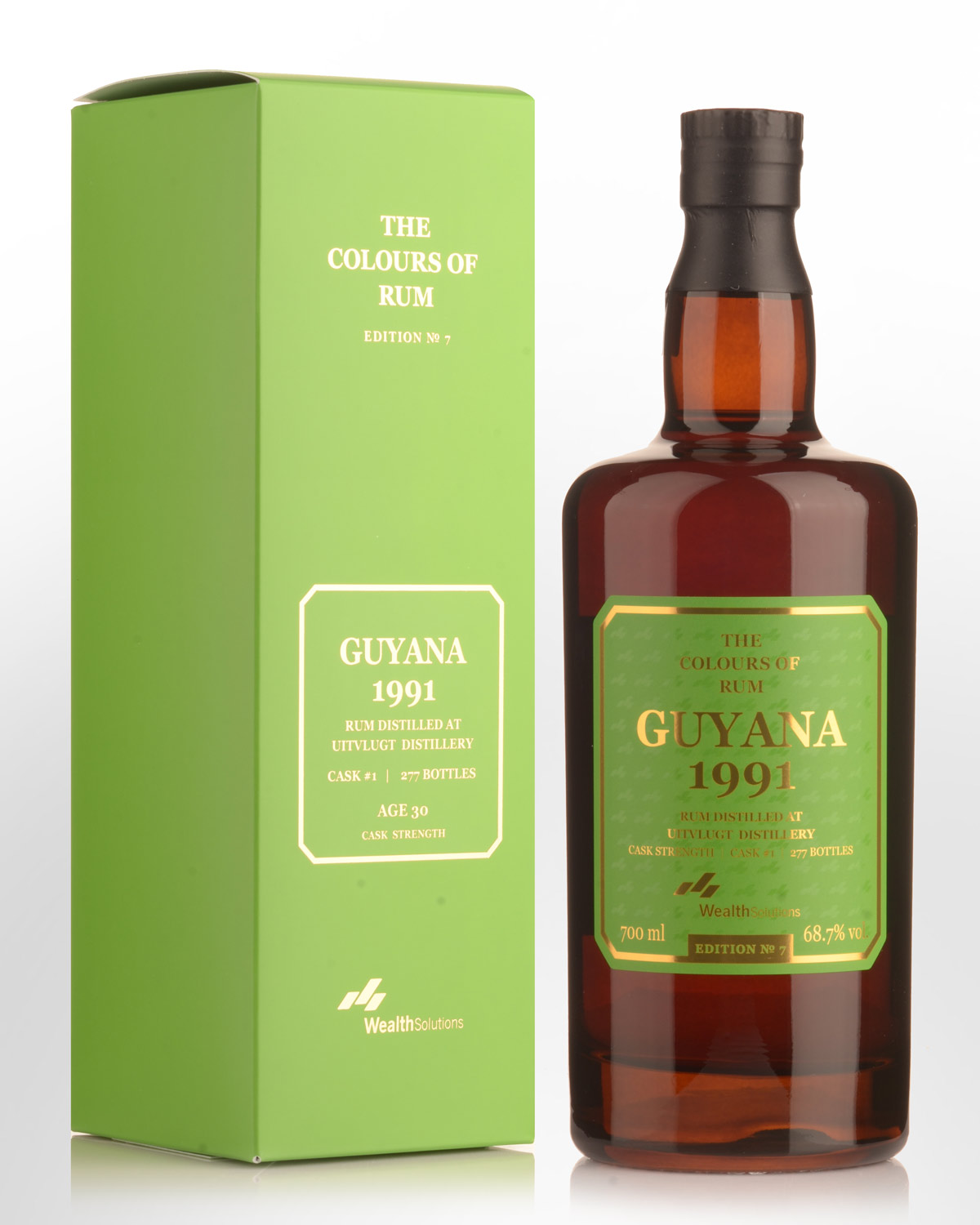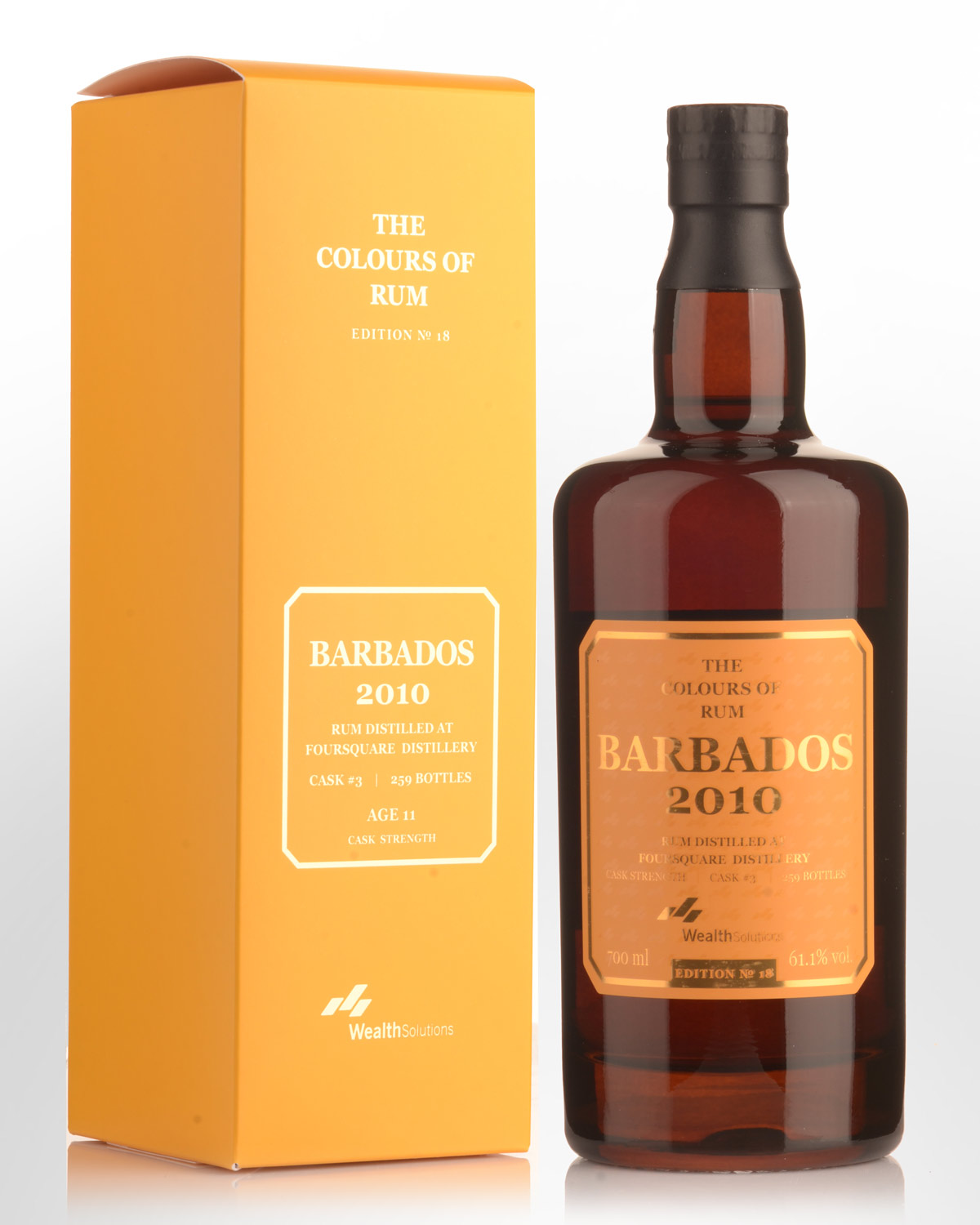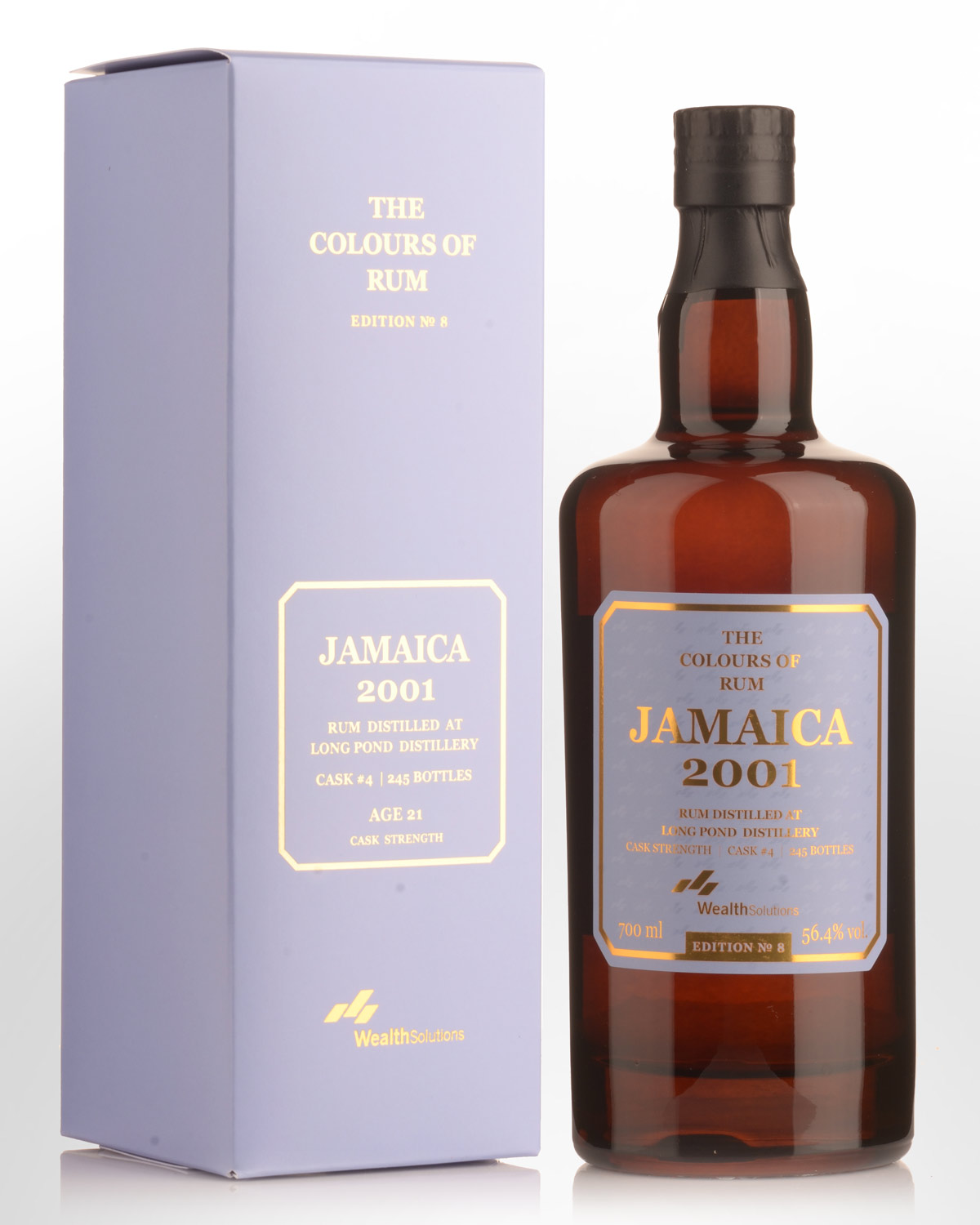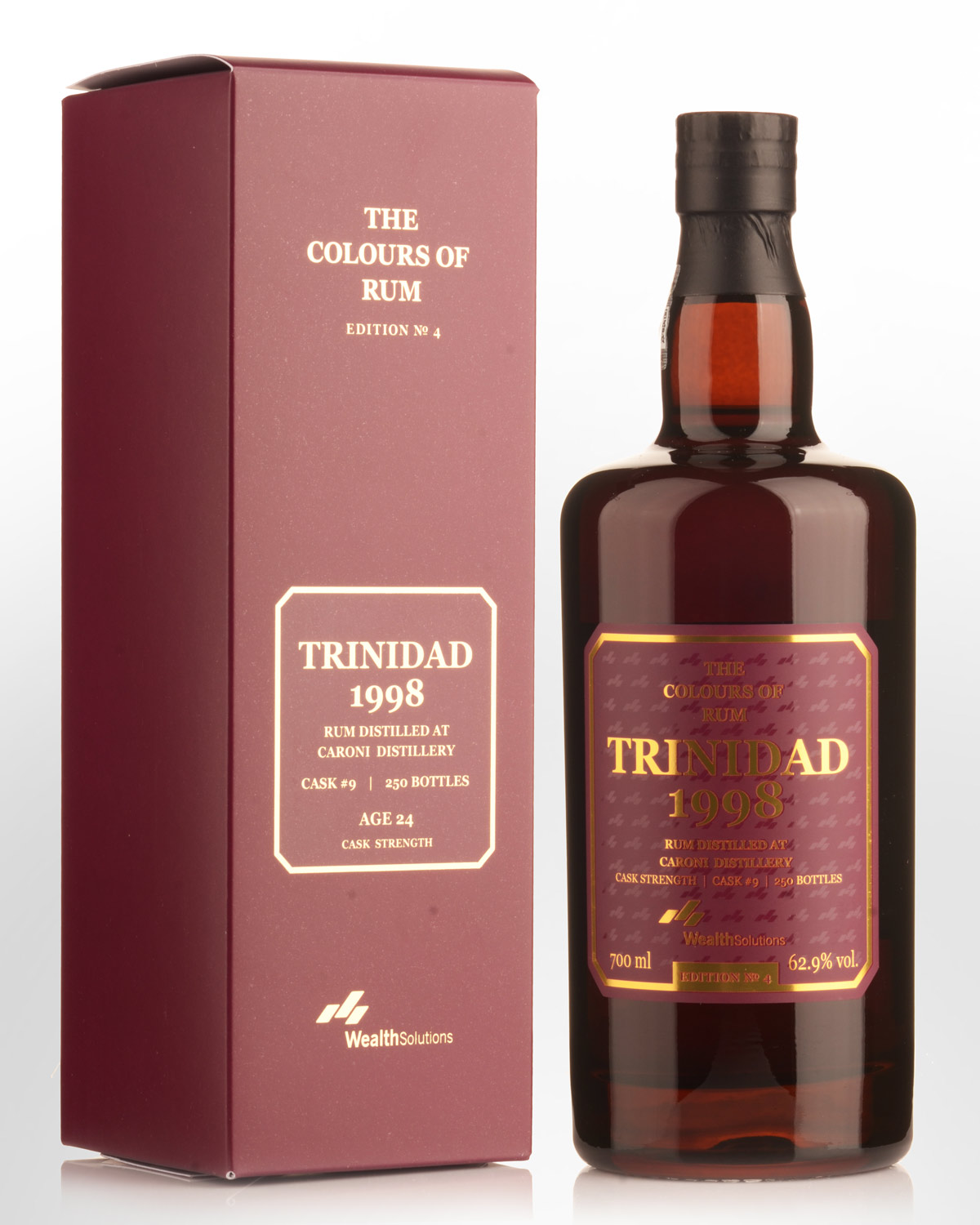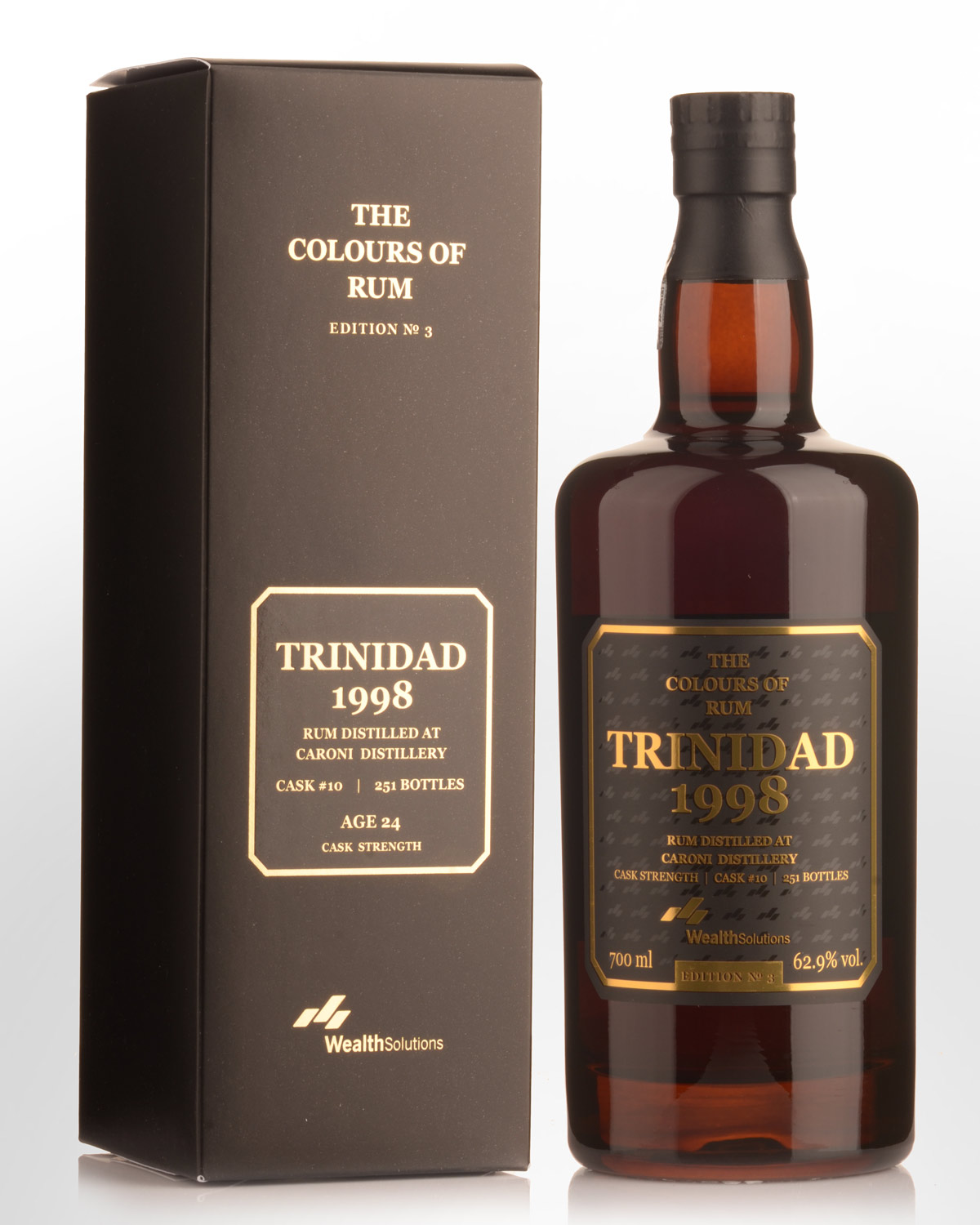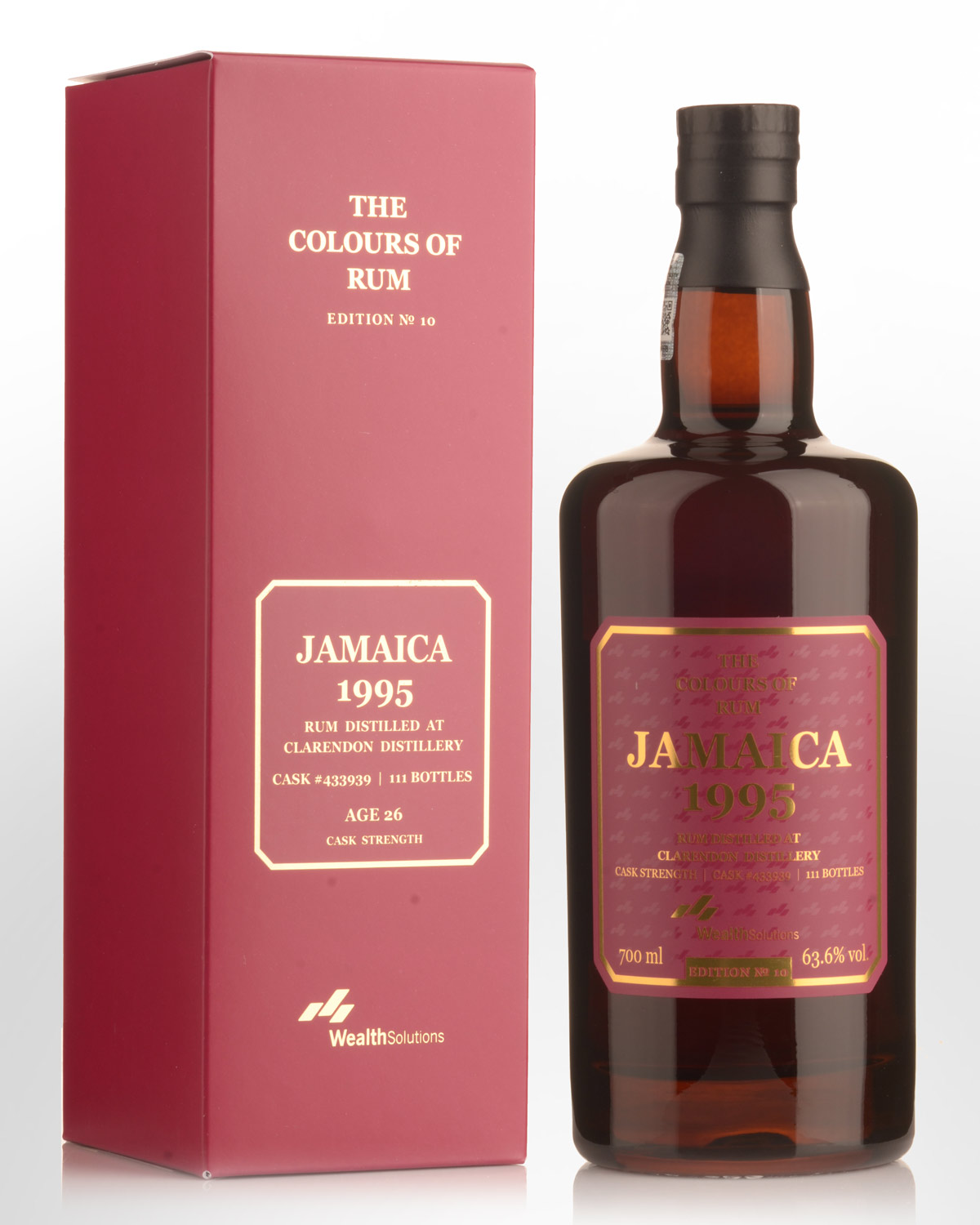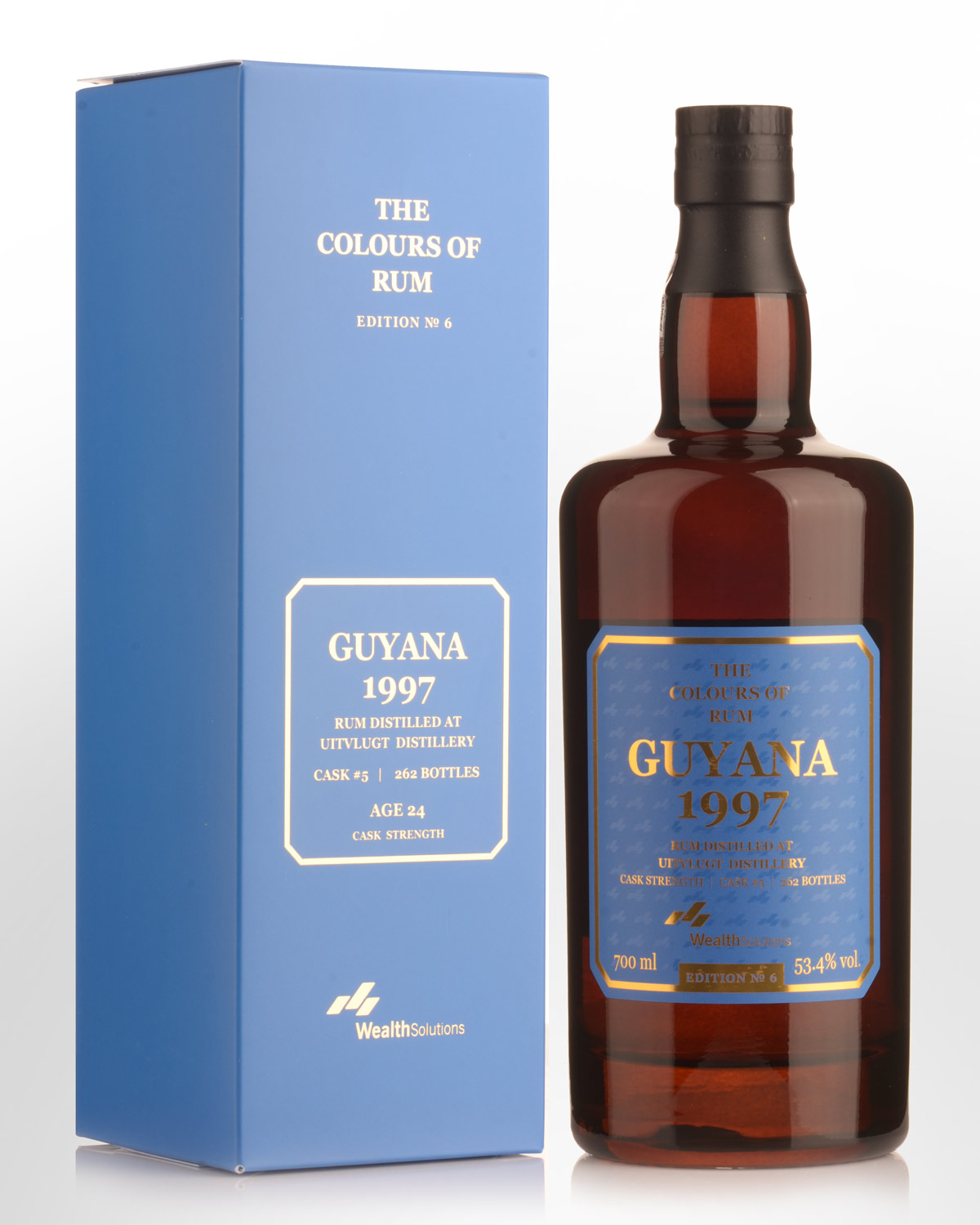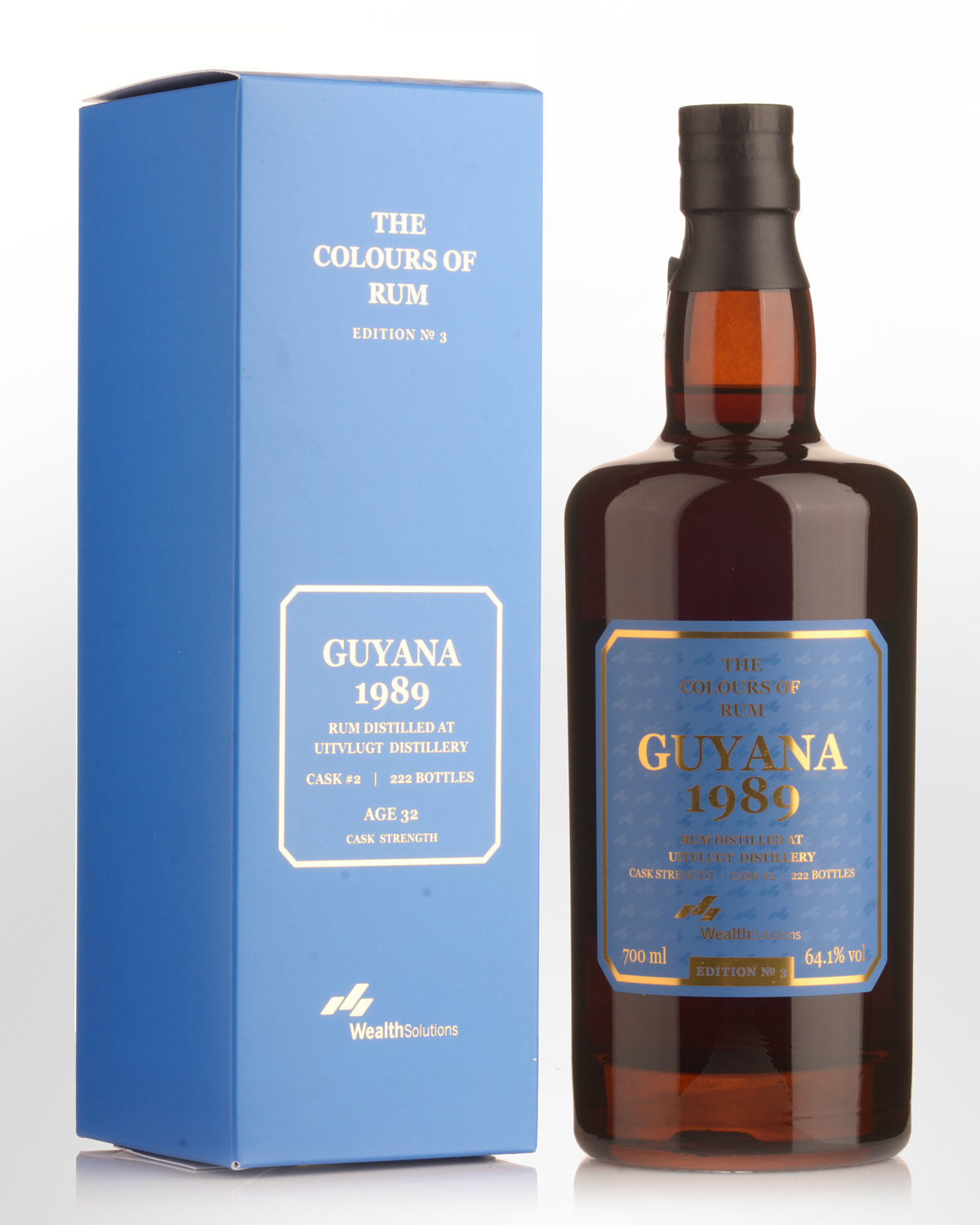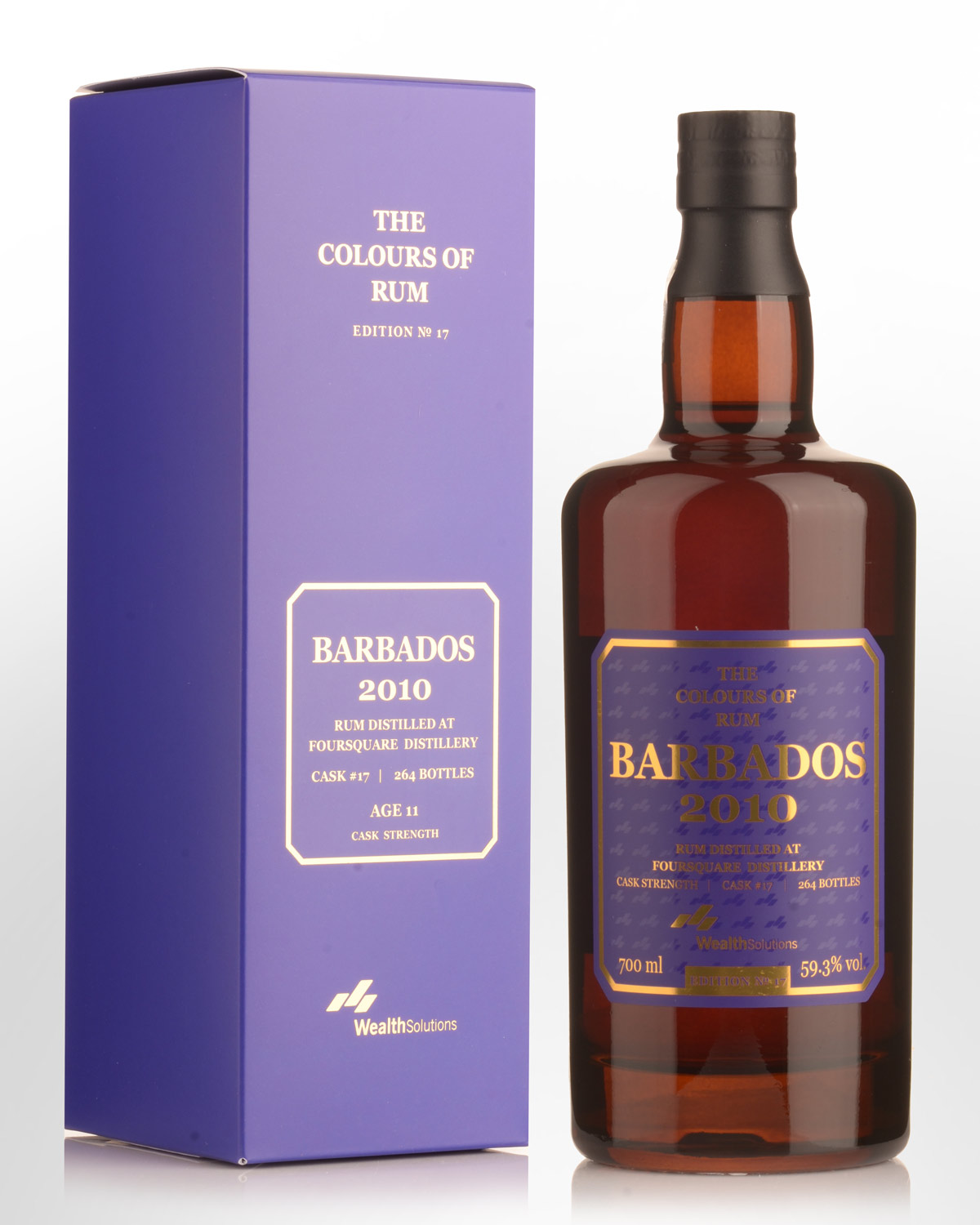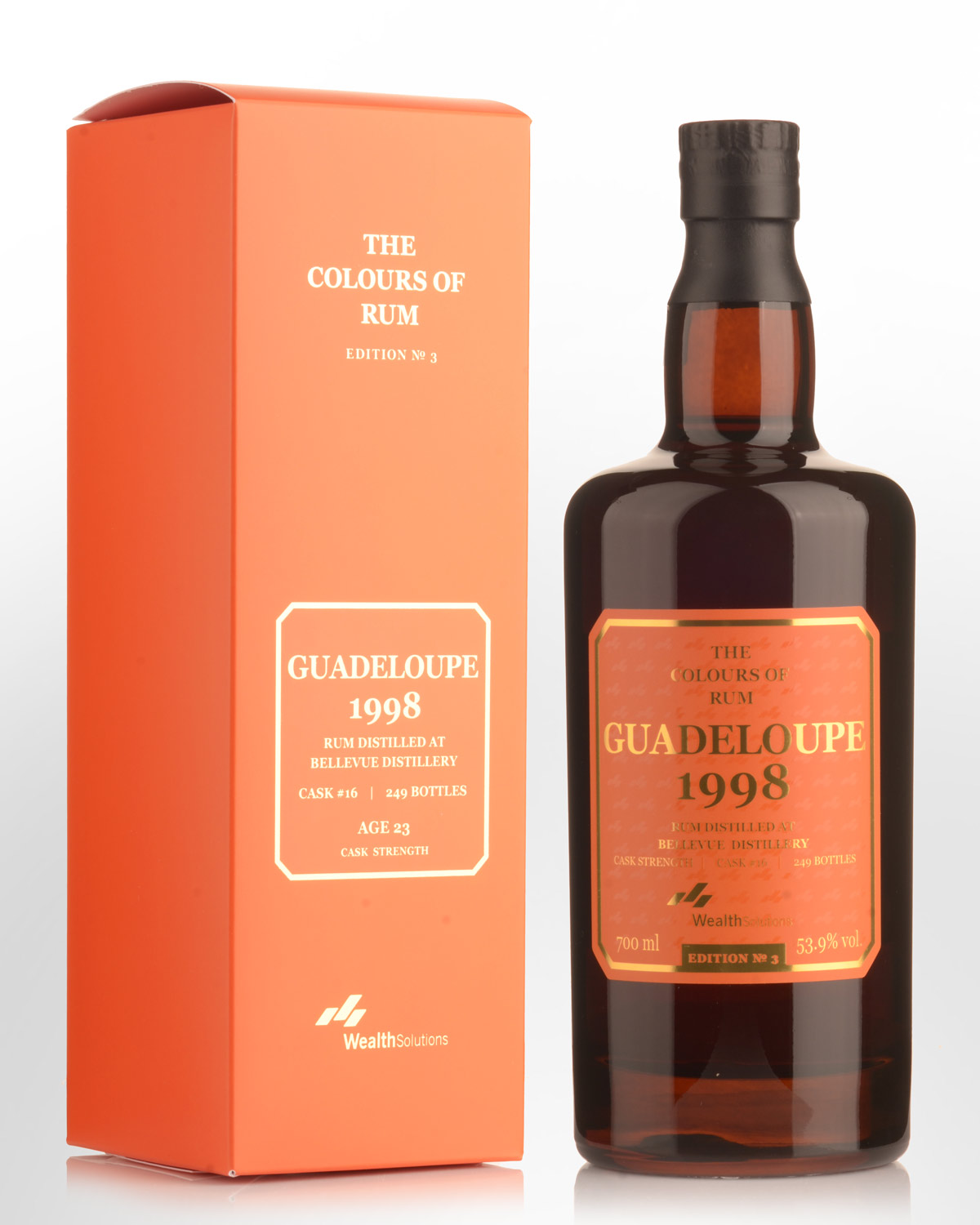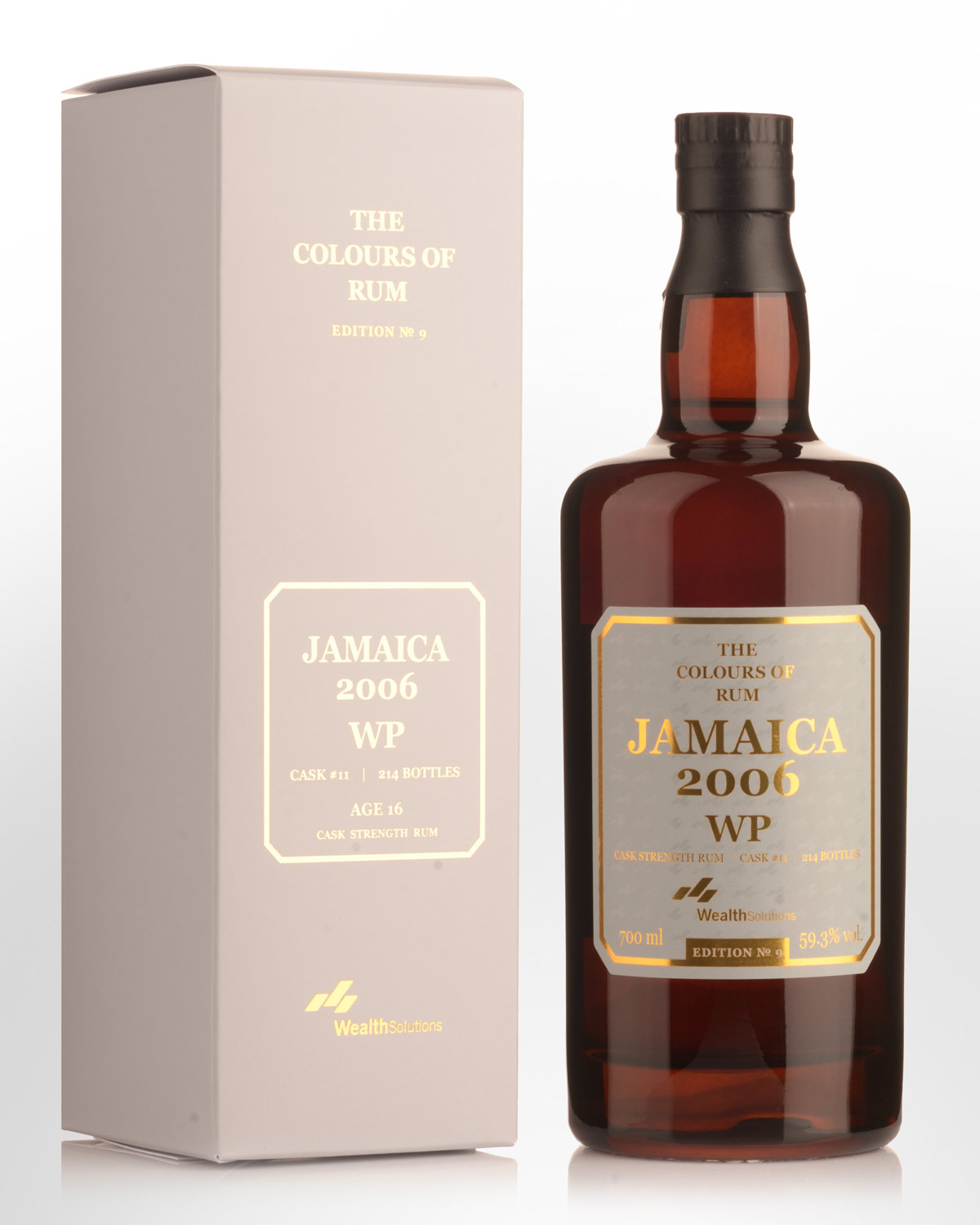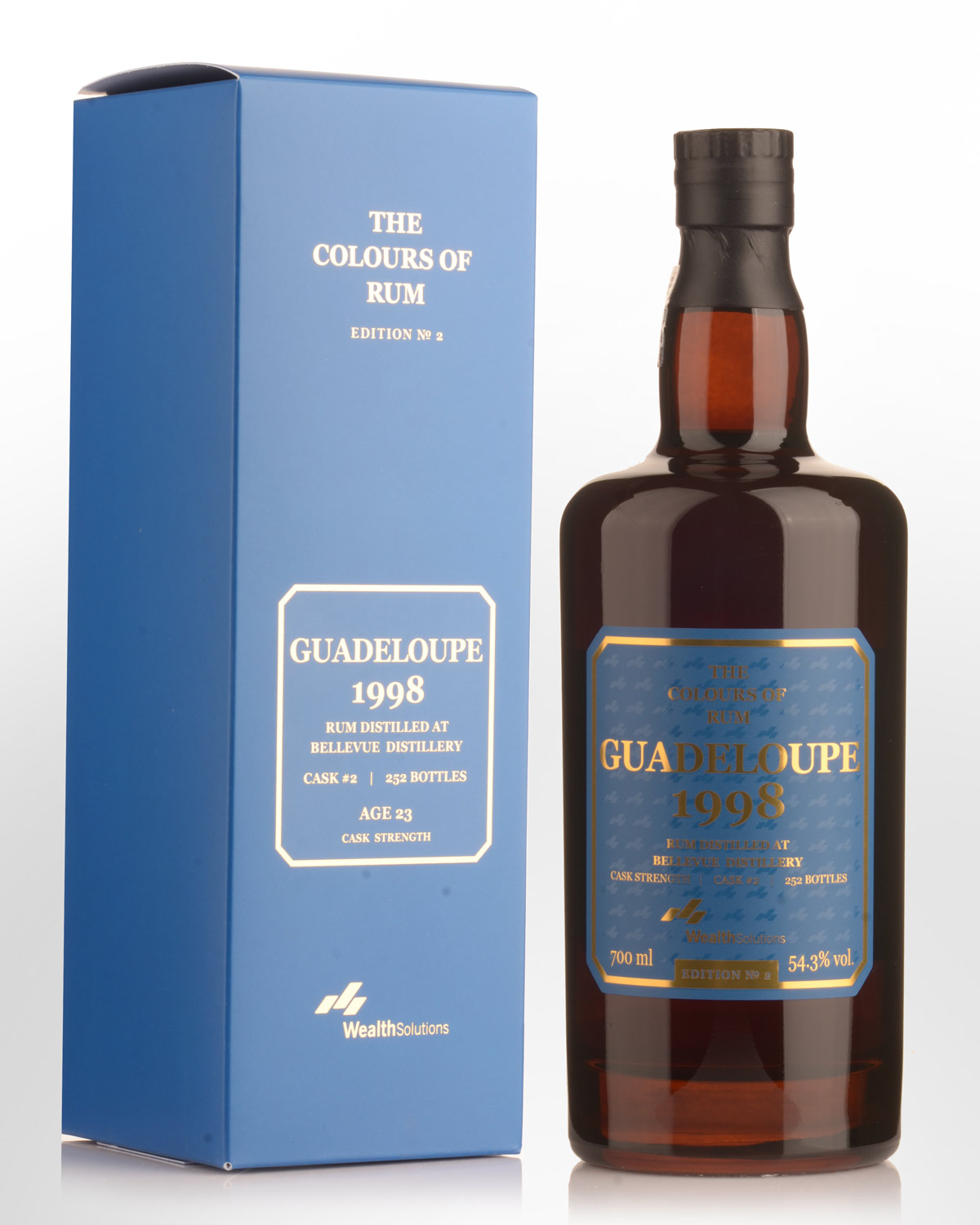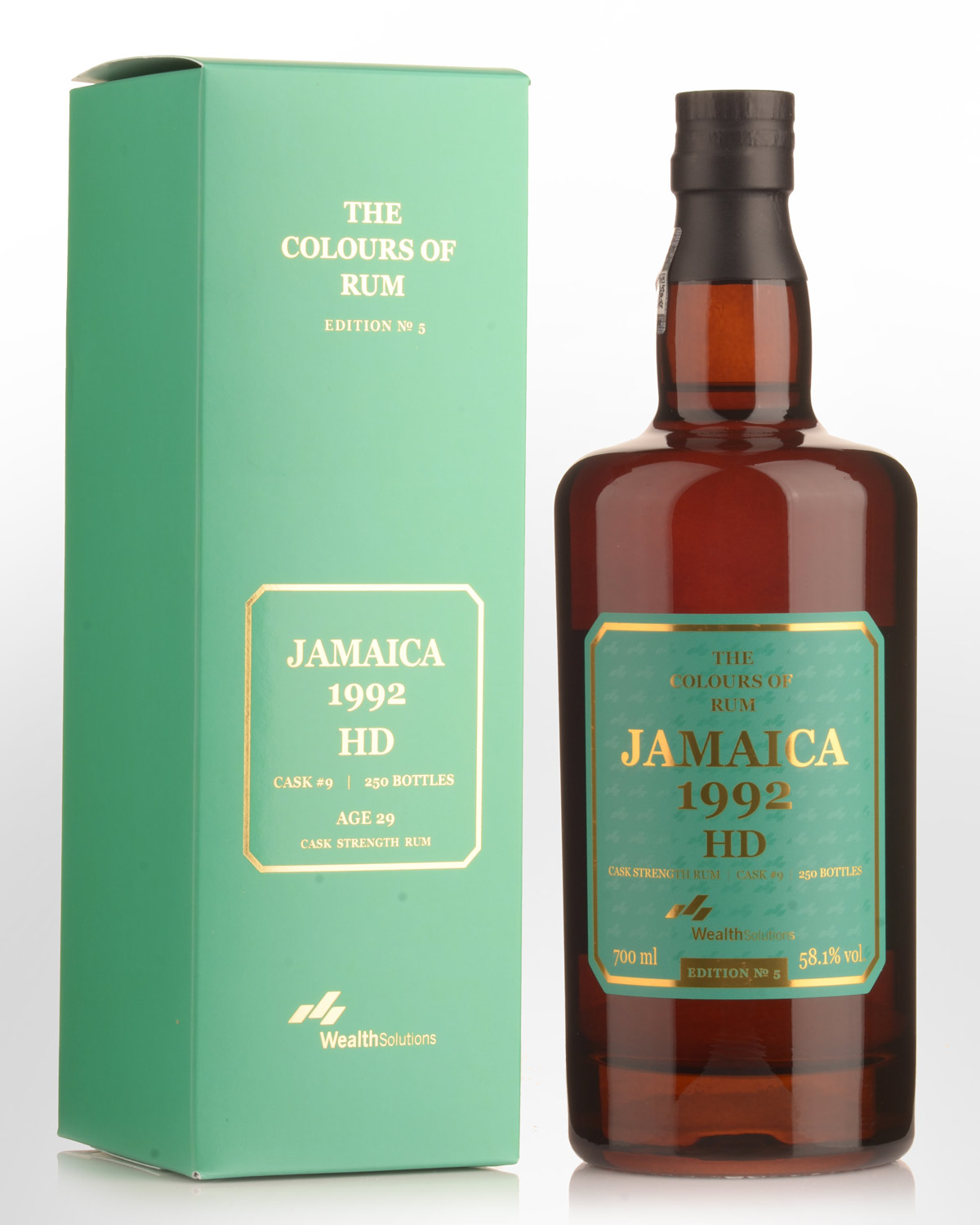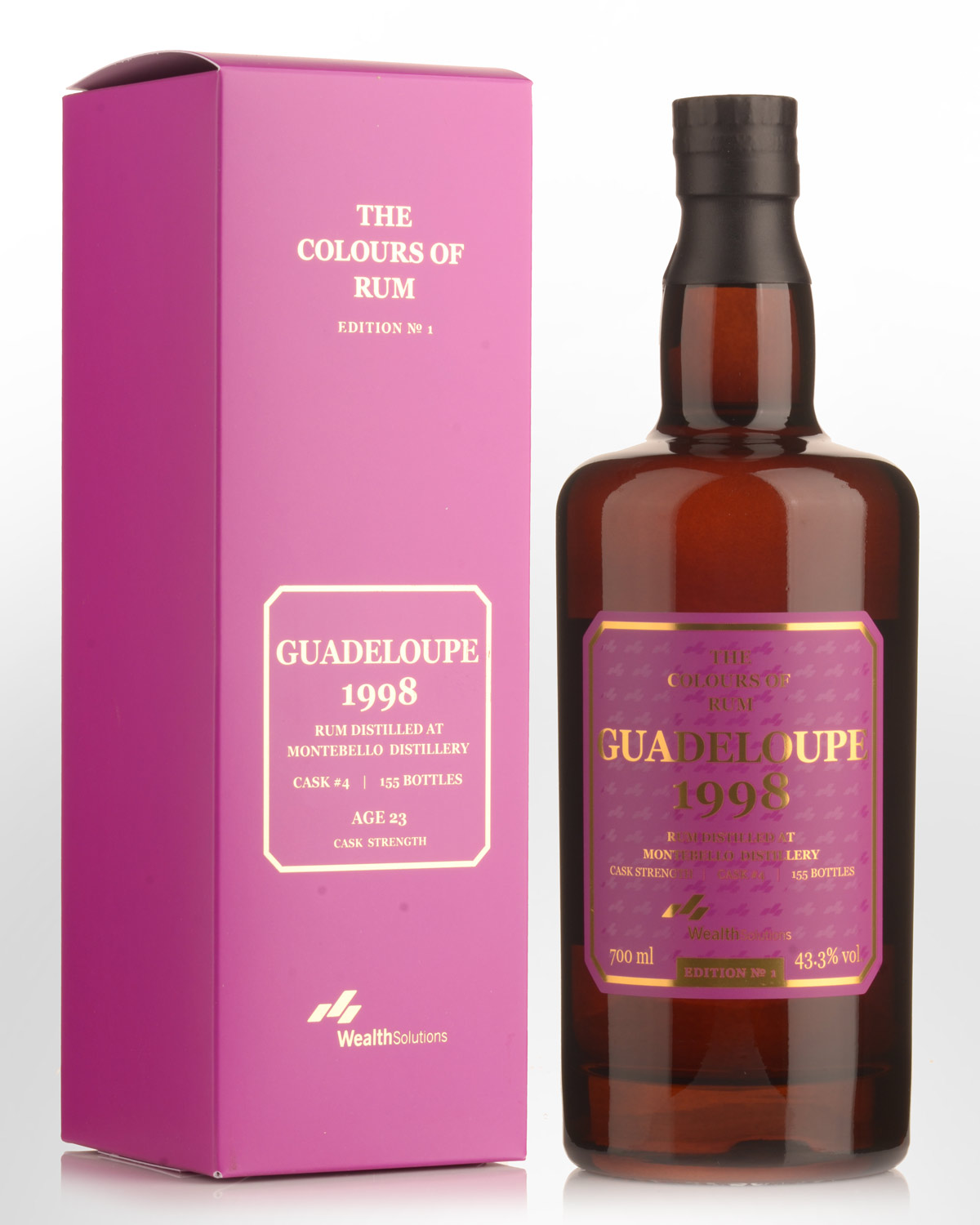Availability:
The Colours of Rum
Wealth Solutions are better known in Europe as bottlers of some of world's greatest spirits, including stunning investment oriented whiskies like 1940s Glen Grants and old Karuizawas. They’ve now introduced a new collection called The Colours of Rum. With a multi-hued minimalist presentation mostly based on country flags, these rums are released in batches - all kinds of distilleries at once, usually at significant age statements. Coinciding with an increasingly critical recognition of the rum category, the collection is attracting enthusiasts who otherwise devoted their attention to high-end single malts. Every bottle comes from a single cask, at cask strength with no sweeteners or other additives. Maturation may take place in the Caribbean or in Europe or both.
![2003 The Colours of Rum Diamond Distillery 18 Year Old Edition No. 5 Cask Strength Guyana Rum (700ml)]() 2003 The Colours of Rum Diamond Distillery 18 Year Old Edition No. 5 Cask Strength Guyana Rum (700ml)$299. 00 Bottle$3588.00 Dozen
2003 The Colours of Rum Diamond Distillery 18 Year Old Edition No. 5 Cask Strength Guyana Rum (700ml)$299. 00 Bottle$3588.00 Dozen![1996 The Colours of Rum Clarendon 25 Year Old Edition No. 3 Cask Strength Jamaica Rum (700ml)]() 1996 The Colours of Rum Clarendon 25 Year Old Edition No. 3 Cask Strength Jamaica Rum (700ml)$450. 00 Bottle$5400.00 Dozen
1996 The Colours of Rum Clarendon 25 Year Old Edition No. 3 Cask Strength Jamaica Rum (700ml)$450. 00 Bottle$5400.00 Dozen![1999 The Colours of Rum Foursquare 22 Year Old Edition No. 13 Cask Strength Barbados Rum (700ml)]() 1999 The Colours of Rum Foursquare 22 Year Old Edition No. 13 Cask Strength Barbados Rum (700ml)$350. 00 Bottle$4200.00 Dozen
1999 The Colours of Rum Foursquare 22 Year Old Edition No. 13 Cask Strength Barbados Rum (700ml)$350. 00 Bottle$4200.00 Dozen![2006 The Colours of Rum Foursquare 15 Year Old Edition No. 15 Cask Strength Barbados Rum (700ml)]() 2006 The Colours of Rum Foursquare 15 Year Old Edition No. 15 Cask Strength Barbados Rum (700ml)$299. 00 Bottle$3588.00 Dozen
2006 The Colours of Rum Foursquare 15 Year Old Edition No. 15 Cask Strength Barbados Rum (700ml)$299. 00 Bottle$3588.00 Dozen![2006 The Colours of Rum Foursquare 15 Year Old Edition No. 16 Cask Strength Barbados Rum (700ml)]() 2006 The Colours of Rum Foursquare 15 Year Old Edition No. 16 Cask Strength Barbados Rum (700ml)$299. 00 Bottle$3588.00 Dozen
2006 The Colours of Rum Foursquare 15 Year Old Edition No. 16 Cask Strength Barbados Rum (700ml)$299. 00 Bottle$3588.00 Dozen![1999 The Colours of Rum Foursquare 22 Year Old Edition No. 14 Cask Strength Barbados Rum (700ml)]() Sold Out1999 The Colours of Rum Foursquare 22 Year Old Edition No. 14 Cask Strength Barbados Rum (700ml)$350. 00 Bottle$4200.00 Dozen
Sold Out1999 The Colours of Rum Foursquare 22 Year Old Edition No. 14 Cask Strength Barbados Rum (700ml)$350. 00 Bottle$4200.00 Dozen![1998 The Colours of Rum HD 23 Year Old Edition No. 6 Cask Strength Jamaica Rum (700ml)]() Sold Out
Sold Out- 94
1998 The Colours of Rum HD 23 Year Old Edition No. 6 Cask Strength Jamaica Rum (700ml)$350. 00 Bottle$4200.00 Dozen![2000 The Colours of Rum Long Pond 21 Year Old Edition No. 11 Cask Strength Jamaica Rum (700ml)]() Sold Out
Sold Out- 94
2000 The Colours of Rum Long Pond 21 Year Old Edition No. 11 Cask Strength Jamaica Rum (700ml)$299. 00 Bottle$3588.00 Dozen![1998 The Colours of Rum HD 23 Year Old Edition No. 7 Cask Strength Jamaica Rum (700ml)]() Sold Out
Sold Out- 95
1998 The Colours of Rum HD 23 Year Old Edition No. 7 Cask Strength Jamaica Rum (700ml)$350. 00 Bottle$4200.00 Dozen![1997 The Colours of Rum Clarendon 24 Year Old Edition No. 13 Cask Strength Jamaica Rum (700ml)]() Sold Out
Sold Out- 93
1997 The Colours of Rum Clarendon 24 Year Old Edition No. 13 Cask Strength Jamaica Rum (700ml)$325. 00 Bottle$3900.00 Dozen![1995 The Colours of Rum Clarendon 26 Year Old Edition No. 2 Cask Strength Jamaica Rum (700ml)]() Sold Out1995 The Colours of Rum Clarendon 26 Year Old Edition No. 2 Cask Strength Jamaica Rum (700ml)$450. 00 Bottle$5400.00 Dozen
Sold Out1995 The Colours of Rum Clarendon 26 Year Old Edition No. 2 Cask Strength Jamaica Rum (700ml)$450. 00 Bottle$5400.00 Dozen![1991 The Colours of Rum Uitvlugt 30 Year Old Edition No. 7 Cask Strength Guyana Rum (700ml)]() Sold Out
Sold Out- 95
1991 The Colours of Rum Uitvlugt 30 Year Old Edition No. 7 Cask Strength Guyana Rum (700ml)Reduced from $699.00$499. 00 Bottle$5988.00 Dozen![2010 The Colours of Rum Foursquare 11 Year Old Edition No. 18 Cask Strength Barbados Rum (700ml)]() Sold Out
Sold Out- 93
2010 The Colours of Rum Foursquare 11 Year Old Edition No. 18 Cask Strength Barbados Rum (700ml)Reduced from $199.00$149. 99 Bottle$1799.88 Dozen![2001 The Colours of Rum Long Pond 21 Year Old Edition No. 8 Cask Strength Jamaica Rum (700ml)]() Sold Out
Sold Out- 96
2001 The Colours of Rum Long Pond 21 Year Old Edition No. 8 Cask Strength Jamaica Rum (700ml)$250. 00 Bottle$3000.00 Dozen![1998 The Colours of Rum Caroni 24 Year Old Edition No. 4 Cask Strength Trinidad Rum (700ml)]() Sold Out
Sold Out- 94
1998 The Colours of Rum Caroni 24 Year Old Edition No. 4 Cask Strength Trinidad Rum (700ml)$799. 00 Bottle$9588.00 Dozen![1998 The Colours of Rum Caroni 24 Year Old Edition No. 3 Cask Strength Trinidad Rum (700ml)]() Sold Out1998 The Colours of Rum Caroni 24 Year Old Edition No. 3 Cask Strength Trinidad Rum (700ml)$799. 00 Bottle$9588.00 Dozen
Sold Out1998 The Colours of Rum Caroni 24 Year Old Edition No. 3 Cask Strength Trinidad Rum (700ml)$799. 00 Bottle$9588.00 Dozen![1995 The Colours of Rum Clarendon 26 Year Old Edition No. 10 Cask Strength Jamaica Rum (700ml)]() Sold Out
Sold Out- 94
1995 The Colours of Rum Clarendon 26 Year Old Edition No. 10 Cask Strength Jamaica Rum (700ml)$499. 00 Bottle$5988.00 Dozen![1997 The Colours of Rum Uitvlugt 24 Year Old Edition No. 6 Cask Strength Guyana Rum (700ml)]() Sold Out
Sold Out- 93
1997 The Colours of Rum Uitvlugt 24 Year Old Edition No. 6 Cask Strength Guyana Rum (700ml)$399. 00 Bottle$4788.00 Dozen![1989 The Colours of Rum Uitvlugt 32 Year Old Edition No. 3 Cask Strength Guyana Rum (700ml)]() Sold Out1989 The Colours of Rum Uitvlugt 32 Year Old Edition No. 3 Cask Strength Guyana Rum (700ml)$699. 00 Bottle$8388.00 Dozen
Sold Out1989 The Colours of Rum Uitvlugt 32 Year Old Edition No. 3 Cask Strength Guyana Rum (700ml)$699. 00 Bottle$8388.00 Dozen![1998 The Colours of Rum Long Pond 23 Year Old Edition No. 12 Cask Strength Jamaica Rum (700ml)]() Sold Out
Sold Out- 94
1998 The Colours of Rum Long Pond 23 Year Old Edition No. 12 Cask Strength Jamaica Rum (700ml)$325. 00 Bottle$3900.00 Dozen![2010 The Colours of Rum Foursquare 11 Year Old Edition No. 17 Cask Strength Barbados Rum (700ml)]() Sold Out
Sold Out- 93
2010 The Colours of Rum Foursquare 11 Year Old Edition No. 17 Cask Strength Barbados Rum (700ml)Reduced from $199.00$149. 99 Bottle$1799.88 Dozen![1998 The Colours of Rum Bellevue 23 Year Old Edition No. 3 Cask Strength Guadeloupe Rum (700ml)]() Sold Out
Sold Out- 95
1998 The Colours of Rum Bellevue 23 Year Old Edition No. 3 Cask Strength Guadeloupe Rum (700ml)$299. 00 Bottle$3588.00 Dozen![2006 The Colours of Rum WP 16 Year Old Edition No. 9 Cask Strength Jamaica Rum (700ml)]() Sold Out
Sold Out- 94
2006 The Colours of Rum WP 16 Year Old Edition No. 9 Cask Strength Jamaica Rum (700ml)Reduced from $250.00$179. 99 Bottle$2159.88 Dozen![1998 The Colours of Rum Bellevue 23 Year Old Edition No. 2 Cask Strength Guadeloupe Rum (700ml)]() Sold Out
Sold Out- 95
1998 The Colours of Rum Bellevue 23 Year Old Edition No. 2 Cask Strength Guadeloupe Rum (700ml)$299. 00 Bottle$3588.00 Dozen![1992 The Colours of Rum HD 29 Year Old Edition No. 5 Cask Strength Jamaica Rum (700ml)]() Sold Out1992 The Colours of Rum HD 29 Year Old Edition No. 5 Cask Strength Jamaica Rum (700ml)$599. 00 Bottle$7188.00 Dozen
Sold Out1992 The Colours of Rum HD 29 Year Old Edition No. 5 Cask Strength Jamaica Rum (700ml)$599. 00 Bottle$7188.00 Dozen![1992 The Colours of Rum HD 29 Year Old Edition No. 4 Cask Strength Jamaica Rum (700ml)]() Sold Out1992 The Colours of Rum HD 29 Year Old Edition No. 4 Cask Strength Jamaica Rum (700ml)$599. 00 Bottle$7188.00 Dozen
Sold Out1992 The Colours of Rum HD 29 Year Old Edition No. 4 Cask Strength Jamaica Rum (700ml)$599. 00 Bottle$7188.00 Dozen![1998 The Colours of Rum Montebello 23 Year Old Edition No. 1 Cask Strength Guadeloupe Rum (700ml)]() Sold Out1998 The Colours of Rum Montebello 23 Year Old Edition No. 1 Cask Strength Guadeloupe Rum (700ml)Reduced from $599.00$399. 00 Bottle$4788.00 Dozen
Sold Out1998 The Colours of Rum Montebello 23 Year Old Edition No. 1 Cask Strength Guadeloupe Rum (700ml)Reduced from $599.00$399. 00 Bottle$4788.00 Dozen
Jamaica is an island that has several seats at the head of the table when it comes to true rum exotica. Sometimes difficult to describe, their aromas and flavours can evoke an almost visceral response: Rotting bananas, overripe tropical fruits and industrial or petroleum-like notes, often referred to as 'hogo' or 'funk' mean that they're polarising, but for those who are “down with the funk,” it simply doesn't get better. The more extreme examples contain elevated levels of organic compounds - esters and higher alcohols - supercharged in long fermentations by wild yeasts and dunder (residue from previous runs). We colloquially call them high ester rums. Because they're so powerful and mostly reserved for blending, you could think of them as the single malts of the Caribbean. Today, just six distilleries make various styles, some owned by large companies, some are smaller independent operations. When bottled all-natural, they offer some of the most exciting rums on the planet.
Ironically, Trinidad’s most sought-after rum hasn’t been made for two decades. TDL (Trinidad Distillers Limited), which is part of the world famous Angostura Company is now the island's sole producer. Between their current output and ever-diminishing supplies of Caroni, the island’s rums aren’t easily pigeon holed. Angostura’s blend of light and medium-weight column distilled spirits is closer to that of Spanish-heritage producers rather than the heavy rums of Jamaica and Guyana. Cask strength bottlings are where the real excitement begins. Caroni broke the mould with its heavier, oily, phenolic distillate that resembles a combination of Demerara and Jamaican styles. Collectors have only recently latched on to the fact that production at Caroni ceased in 2003. The remaining 18,000 casks were sold off piecemeal to bidders, including various independent bottlers. These are now considered investments, with no end in sight.
More than a few rum aficionados consider Barbados an ideal introduction to the category. Bajan rum is enjoyable and “rummy” without veering into the bolder (and let’s face it) more polarising flavours found in funky Jamaicans, grassy agricoles or the wild fermentation-induced complexities of Haitian Clairin. The most popular exported Barbadian rums are typically blends of column and pot distilled spirits. Fans of additive-free styles will find many choices here. Three key distilleries are Foursquare, Mount Gay and The West Indies Distillery (which produces Cockspur rum). However, it's Foursquare that's fast becoming one of the brightest stars in the Caribbean firmament. For anyone seeking high-quality 'malternatives' without breaking the bank, look no further. The fourth generation venture is headed by Richard Seale, one of the most vocal spokespersons for pure and unadulterated rums in the region. His talent and drive led noted spirits authority, Fred Minnick to describe Foursquare as "the Pappy of rum."
Guyana offers what are arguably the world’s most full bodied rums. It’s also the most storied region. The Dutch were the first Europeans to settle in Guyana. Circa 1815, the British took control and wasted no time ramping up sugar production. Rum followed. Partly due to cost and material availability, stills were constructed of Greenheart wood, an abundant, local hardwood. Historically, Demerara rum was considered heavy, similar in some respects to dark Jamaicans, with burnt as a common descriptor. That style found particular favour with the Royal Navy blenders. Hundreds of rum distilleries once dappled the coastline, but dire economic circumstances forced consolidation and closures - of which Uitvlugt is perhaps the most famous. That led to the formation of Demerara Distillers Ltd, now Guyana’s sole rum-making entity. Ten stills, including three heritage wooden stills can make nearly anything under the sun, but the most iconic and sought-after flavour profile remains that of the heavy, oily rums emanating from centuries-old historical equipment.
Those looking for a contrast will find pleasure in agricole-style French Caribbean rums produced on several islands to the north of Guyana. While they may lack the global footprint of molasses-based rum, rigorous regulations and strict adherence to high-quality production standards make it hard to find anything less than stellar examples out of Martinique and the lesser known Guadeloupe. The latter has regulations somewhat similar to Martinique’s AOC but allow for molasses-based rums and batch distillation. As one of the last "hidden gems" in the world of spirits, these rums, sometimes a combination of both free run juice and molasses, are faraway from the marketing ploys and bill boards of multinational brands.

